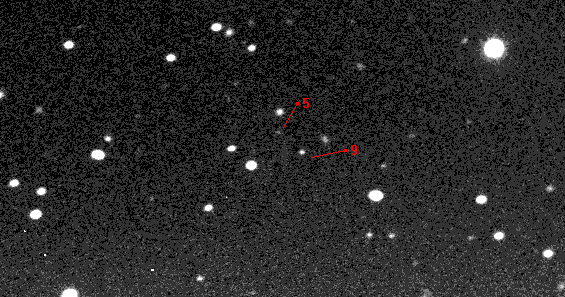2003 UB313: Solar System's new planet
Observed: 5, 9 August 2005
M. Bonnardeau
9 August 2005
Updated 11 Sept 2005
Abstract
This newly discovered planet is observed with a 20 cm telescope.
Introduction
The annoncement of the discovery of 2003 UB313 was made on July 29,
2005. It was discovered at the Palomar Observatory by M. Brown, C. Trujillo
and D. Rabinowitz.
It is bigger than Pluto.
It has a semi-major axis of 96 au, completes a revolution around the Sun in 557 yr,
and its orbit is inclined by 44°. (For Pluto, the figures are: 30 au, 248 yr, 17°).
Observations
I observed UB313 with a 203 mm SC telescope, a Clear filter and a SBIG ST7E camera
(KAF401E CCD). On August 5, I obtained a 10x200 s image, and on the 9, a 11x200+5x60 s
image. Below is an animated image made from these 2 images, showing the N-E -> S-W
displacement of the object:

The coordinates of the image center are RA=01h39mn19s DEC=-5°20'43".
North is up, East is left, the scale is 1.4"/pixel. The magnitude of UB313 is 18.5,
from the USNO-A2 catalog, R magnitudes. The S/N is 6.4 for the August 9 frame.
How many planets?
How many planets are there in the Solar System? Is UB313 a minor planet (an asteroid) or a planet?
So far there is no universally accepted definition for planet. Up to the discovery of UB313, Pluto was considered to be the ninth planet, although it has been argued it could be an asteroid, because of its eccentricity and inclination.
Link
Technical notes
Telescope and camera configuration.
Software and computer configuration.
|
|
|||
|
|||
|
|
|||
|
|
|||
|
|||
